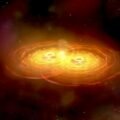For fans of the original Star Wars: A New Hope, few if any moments from the epic 1977 space opera are as memorable or as potent as the Galactic Empire’s dreaded Death Star firing up its primary laser cannon array and blasting Princess Leia’s home planet Alderaan to smithereens.
For Earth’s scientists, the ability to merge multiple lasers into one coherent beam like the Death Star’s planet-killing weapon have remained in the realms of science fiction, but based on new research, that limitation may finally be a thing of the past.
That’s because a team of researchers from the University of Würzburg led by Alex Dikopoltsev from the Israeli Institute of Technology (Technion) have successfully merged a 30-laser array into one coherent, ultra-powerful beam, bringing the dreams of a Death Star cannon closer to reality.
“The output power from a laser system can be increased by forming an array of lasers,” reads the recently published research results, “however, because the individual lasers are independent, the resultant output may not be coherent.”
But now, the research paper’s summary adds, “Dikopoltsev et al. demonstrated that the VCSEL array emits at a single frequency and displays interference, highlighting the array’s mutual coherence.”
Background: Does it Make That Weird Power Down Sound like in the Movie?
Lasers are used every day in research, industry, and even medicine, often providing a unique tool for scientists, doctors, and engineers alike. However, in applications where extremely high power outputs are required, like military weapons systems or fusion energy research, engineers have tried to join multiple lasers together to meet those energy demands, just like the Galactic Empire’s doomsday weapon, only on a smaller scale.
“The power output from a laser system can be increased by forming an array of lasers,” the press release announcing the research states. “However, because the individual lasers within the array are independent, the resulting combined output may not be coherent.”
This lack of coherency has repeatedly stifled attempts to combine lasers like the planet-killing beam used by the Death Star, but Dikopoltsev and his team decided to take a new approach which, according to their research results, seems to have done the trick.
Analysis: It’s a Trap!
First, the Wurzburg – Technion team zeroed in on a specific type of laser known as a “Vertical Cavity Surface Emitting Laser,” or VCSEL, specifically because of its wide usage in industrial and commercial applications. The downside to these lasers, which are emitted vertically from pillars fabricated right on to a semiconductor chip, is that the power they emit is minimal.
“While broadly useful due to their size and configuration, the power emitted from a single VCSEL is small,” the study’s press release states. “Thus, developing VCSEL arrays that emit coherent light and act as a single high-power laser source has been challenging.”
To conquer this challenge, the team built and assembled an array of 30 VCSEL lasers, then positioned them in a unique way that they hoped would force all 30 into one coherent beam using what they describe as a “topological” design.
“The topological insulator VCSEL array is composed of two types of honeycomb lattices stacked on either side of a topological interface,” the study states, explaining the unique profile of the team’s successfully coherent laser array. “When individual VCSELs emit through the topological-crystalline honeycomb, the light waves become injection-locked, facilitating coherent emission of the entire array.”
The study explains that this “injection-locked” state is a direct result of the honeycomb lattice’s unique design, which causes the beams passing through it to coalesce, delivering their combined power as one coherent beam.
“Our experiments exemplify the power of topological transport of light,” the study authors conclude. “The light spends most of its time oscillating vertically, but the small in-plane coupling is sufficient to force the array of individual emitters to act as a single laser.”
Outlook: The Debrief Could Use its Own Death Star Laser…
Darth Vader himself once warned his colleagues that the power of the Death Star was insignificant compared to the power of the force. That may be true in a galaxy far, far away, but here on Earth, military, industrial, and even some medical applications will significantly benefit from the ability to combine the power of multiple lasers into one ultra-powerful beam.
“This development will be important for realizing large-scale coherent laser arrays,” the study’s summary concludes.
Given the seemingly growing trend of science fiction becoming science fact, this may even mean that one day in the not too distant future, a Death Star-style laser array may indeed be aimed at a target planet and tasked with blasting that planet to bits. Somewhere the ghost of Grand Moff Tarkin is smiling (almost).
Follow and connect with author Christopher Plain on Twitter: @plain_fiction
Don’t forget to follow us on Twitter, Facebook, and Instagram, to weigh in and share your thoughts. You can also get all the latest news and exciting feature content from The Debrief on Flipboard, and Pinterest. And subscribe to The Debrief YouTube Channel to check out all of The Debrief’s exciting original shows: DEBRIEFED: Digging Deeper with Cristina Gomez –Rebelliously Curious with Chrissy Newton
